On January 24, at a press conference held by the China Meteorological Administration (CMA), the 2024 China Wind and Solar Energy Resources Annual Outlook Bulletin (hereinafter referred to as the Bulletin) was officially released.
The Bulletin has a 2024 national wind energysolar energyThe resource situation and the change of the average resource relative to the past 10 years and 30 years are analyzed, according to which the relevant enterprises in the energy industry can review and evaluate the wind and solar power generation capacity in 2024, so as to optimize the production process, which will help to further play the role of high value of the meteorological data, enhance the power generation capacity and operational efficiency, and empower the development of new-quality productivity.
(i) Horizontal solar resources
1. The national average annual total horizontal irradiation is slightly lower than normal
In 2024, the solar energy resources of the country as a whole will be slightly less than normal (Fig. 2.1). The national average annual total horizontal irradiation is 1511.8kWh/m², which is 9.5kWh/m² less than the average value of the last 30 years, 4.9kWh/m² less than the average value of the last 10 years, and 4.3kWh/m² less than the average value of 2023.
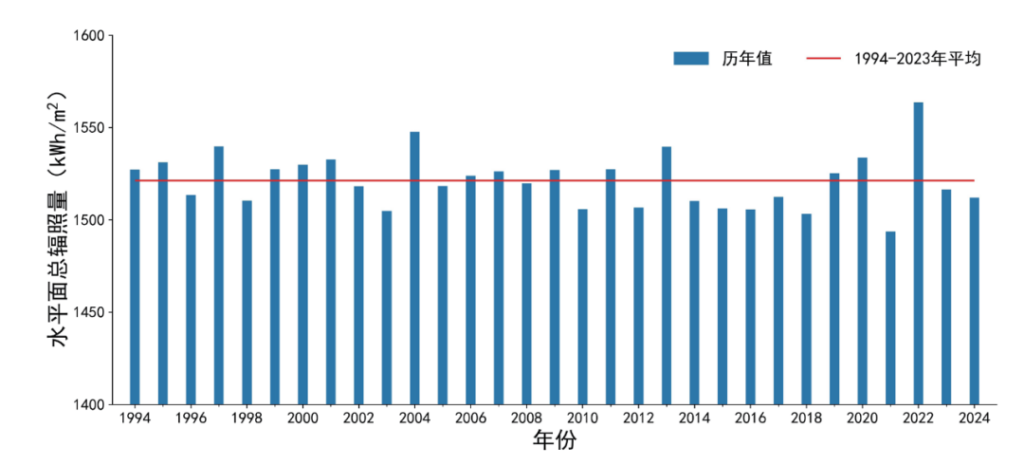
Inter-annual variation in national average annual total horizontal irradiation (in kWh/m2 )
2. Total horizontal irradiation is greater in the west than in the east-central region
China's solar energy resources have large regional differences, showing that the western region is larger than the central and eastern regions, the plateau, less rainy and dry region is large, and the plains, rainy and high humidity region is small (Figure 2.2).
According to China's solar energy resources total grade classification standard "solar energy resources grade total radiation" (GB/T 31155-2014)1, in 2024, Tibet, north-central Qinghai, western Sichuan and other places with annual total irradiation of more than 1,750kWh/m2 , for the most solar energy resource-rich area; Xinjiang, eastern Tibet, Inner Mongolia, northwestern central and western China, north China, western China, southern China and other places with annual total irradiation of 1,400kWh/m2 to 1,750kWh/m2 , for the very solar energy resource-rich area; northeastern part, eastern northwestern China, north-eastern China and other parts of the country. Xinjiang, eastern Tibet, most of Inner Mongolia, central and western Northwest China, most of northern China, western South China, and northeastern China have annual total horizontal irradiance of 1400kWh/m2 to 1750kWh/m2 , which is the most abundant solar resource area; most of Northeast China, eastern Northwest China, central China, south-central China, and southern China have annual total horizontal irradiance of 1050kWh/m2 to 1400kWh/m2 , which is the most abundant solar resource area; and eastern Southwest China, and central and western China have annual total horizontal irradiance of 1400kWh/m2 to 1400kWh/m2 , which is the most abundant solar resource area. The annual total horizontal irradiation of eastern Southwest China, western central China and other places in the country is less than 1050kWh/m2 , which is a general solar energy resource area.
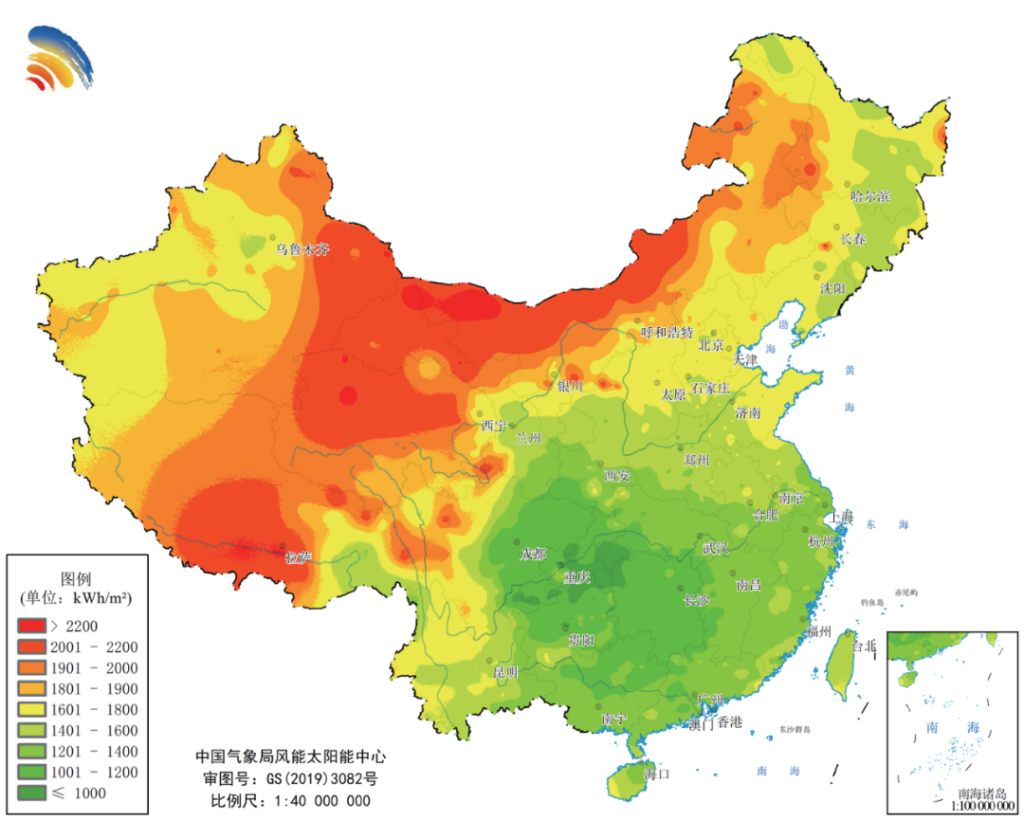

3. Total horizontal irradiation is smaller than normal in western and southern China and larger than normal in most of central and eastern China.
There are regional differences in the distribution of the annual total horizontal irradiation. In general, the total horizontal irradiation is smaller than normal in the west and south of China, and larger than normal in most of the central and eastern parts of the country (Fig. 2.3). The details are as follows:
(1) Minor situation: Compared with the average value of total horizontal irradiation in the past 30 years, in 2024, the irradiation in most parts of Xinjiang, northern and eastern Tibet, most parts of Northwest China, most parts of Inner Mongolia, most parts of Northeast China, western Southwest China, and South China was small; in southern Xinjiang, eastern Tibet, eastern Qinghai, Ningxia, central and western Inner Mongolia, eastern Heilongjiang, western Sichuan, central and western Yunnan, southern Guangxi, and southern Guangdong, it was significantly small; in southern Xinjiang, eastern Tibet, southern Qinghai, Ningxia, southern Inner Mongolia, eastern Heilongjiang, western Sichuan, western Yunnan, and southern Guangxi, it was abnormally small. The average size of the rainy season was significantly smaller in southern Xinjiang, eastern Tibet, southern Qinghai, Ningxia, southern Inner Mongolia, eastern Heilongjiang, western Sichuan, western Yunnan, southern Guangxi and southern Guangdong, and abnormally smaller in other places.
(2) Large situation: Southeast Northwest China, southern North China, most of central China, northeast central China, and east-central Southwest China are large; southern Gansu, southern Shaanxi, eastern Sichuan, most of Guizhou, southern Chongqing, southern Hebei, eastern Henan, southeastern Shandong, and most of Anhui are obviously large; southern Gansu, southern Shaanxi, eastern Sichuan, most of Guizhou, southern Chongqing, eastern Henan, and central Anhui are abnormally large; the situation is not as large as it should be. The average size of the area is abnormally large.
From the distribution of provinces (autonomous regions and municipalities) (Fig. 2.4), the annual total horizontal irradiation in Ningxia, Qinghai and Yunnan is significantly smaller than the average value of the last 30 years; in Inner Mongolia, Tibet, Gansu, Xinjiang, Liaoning, Hainan, Jilin, Guangdong, Sichuan, Beijing, Shanghai, Heilongjiang, Hebei and Shaanxi, it is smaller; in Hubei, Jiangsu, Henan, Shandong and Tianjin, it is larger; in Anhui and Chongqing, it is significantly larger; and in Guizhou it is abnormally larger.
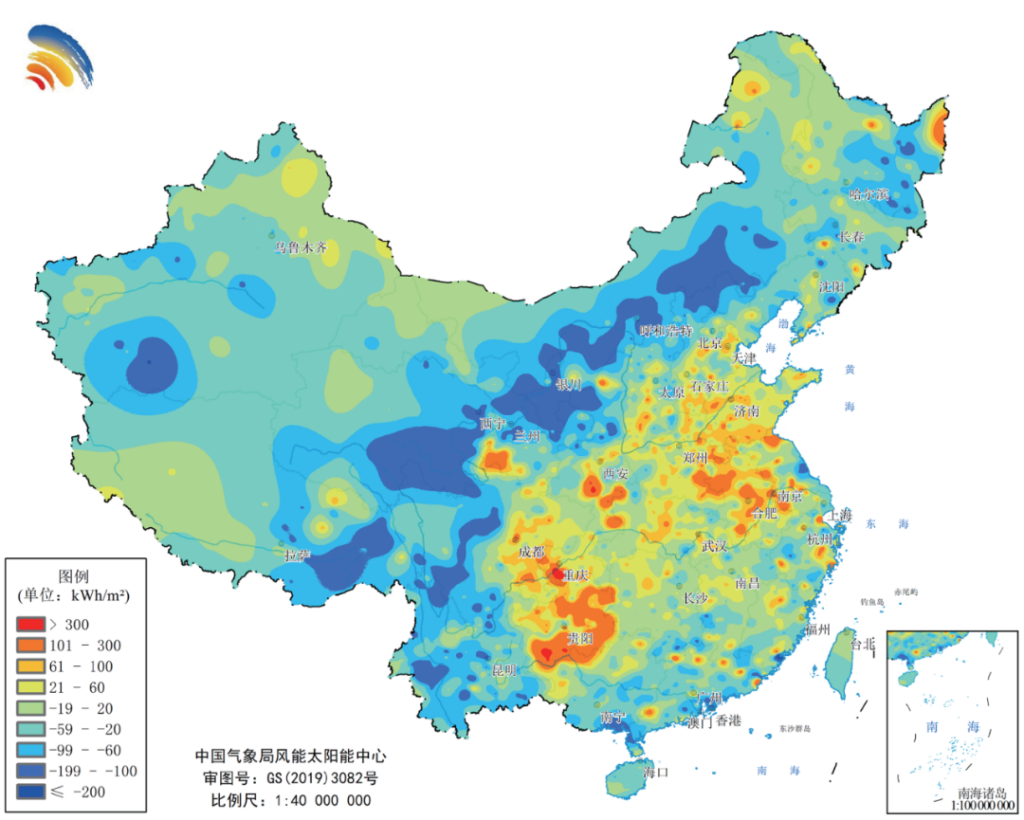
Distribution of annual total horizontal irradiation distance level (in kWh/m²) across the country in 2024
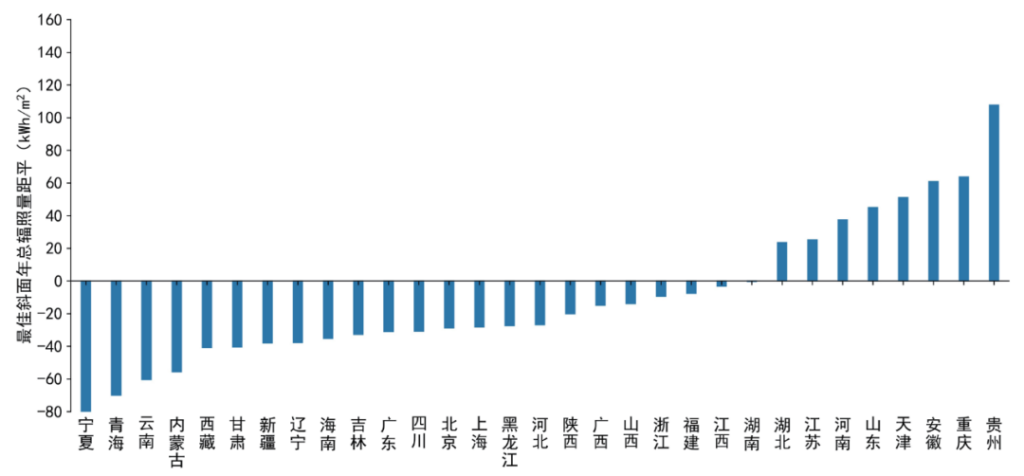
Distance level of total annual horizontal irradiation (in kWh/m²) by province (district and city) in 2024
(ii) Fixed photovoltaic solar energy resources
The solar energy resource available for stationary PV power generation is the total solar irradiation that can be received by the PV modules when they are placed at the optimal tilt angle (referred to as the "optimal total oblique irradiation"). Based on the current design experience in China, the first year utilization hours of fixed PV power plants are calculated according to the overall system efficiency of 83%. Figure 2.5 shows the spatial distribution of the optimal tilt angle for stationary PV power generation in China.
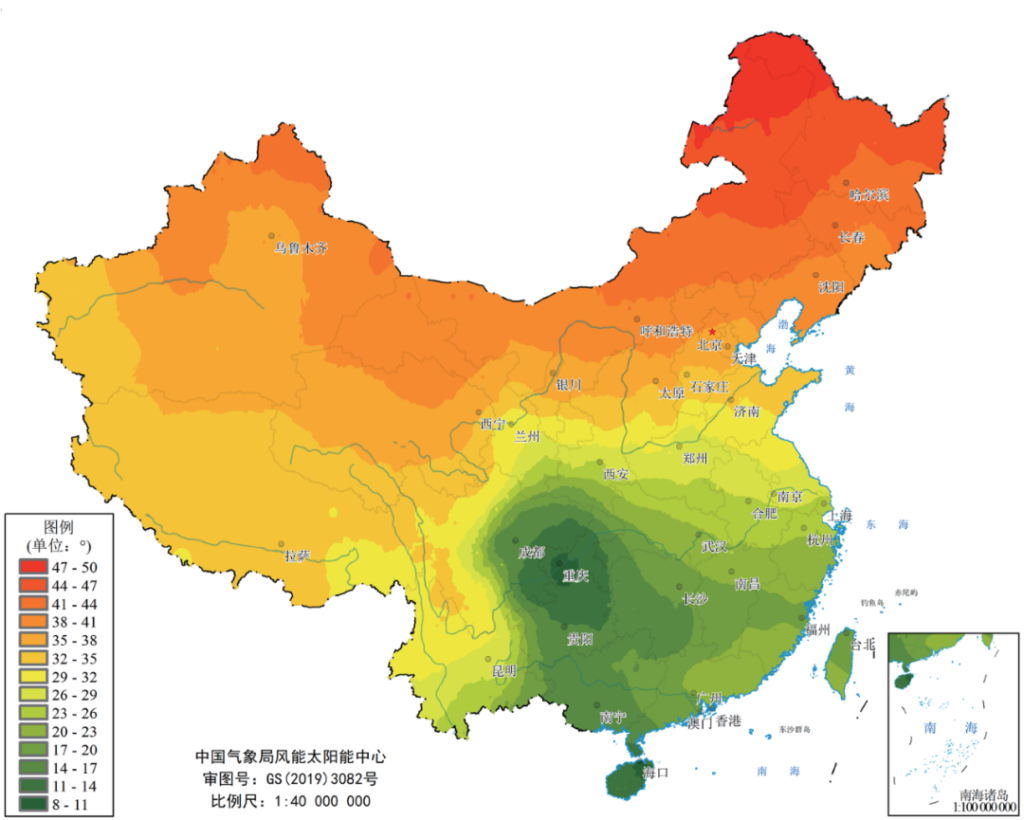
National optimal tilt angle distribution of stationary photovoltaic power generation
1. The national average annual optimal oblique total irradiance is slightly smaller than normal
In 2024, the national average annual total irradiation of the best slope is 1733.9 kWh/m², which is 14.0 kWh/m² less than the average value of the last 30 years, 6.9 kWh/m² less than the average value of the last 10 years, and 6.5 kWh/m² less than the average value of the last 2023; the average number of hours of utilization of stationary photovoltaic power plants for the first year in 2024 is 1,439.1, which is 11.6 hours less than the average value of the last 30 years, 5.7 hours less than the average value of the last 10 years, and 5.4 hours less than the average value of 2023. In 2024, the average utilization hours of fixed PV power plants in the first year in China will be 1439.1 hours, which is 11.6 hours less than the average value of the last 30 years, 5.7 hours less than the average value of the last 10 years, and 5.4 hours less than the average value of 2023.
2. Optimal slope total irradiation and first-year utilization hours of photovoltaic power generation are greater in the western region than in the central-eastern region
The spatial distribution of the total irradiation of the best slopes in the country and the utilization hours of photovoltaic power generation in the first year is generally larger in the western region than in the central and eastern regions, and is larger in the plateau and dry areas with less rain and smaller in the plains and high humidity areas with more rain.
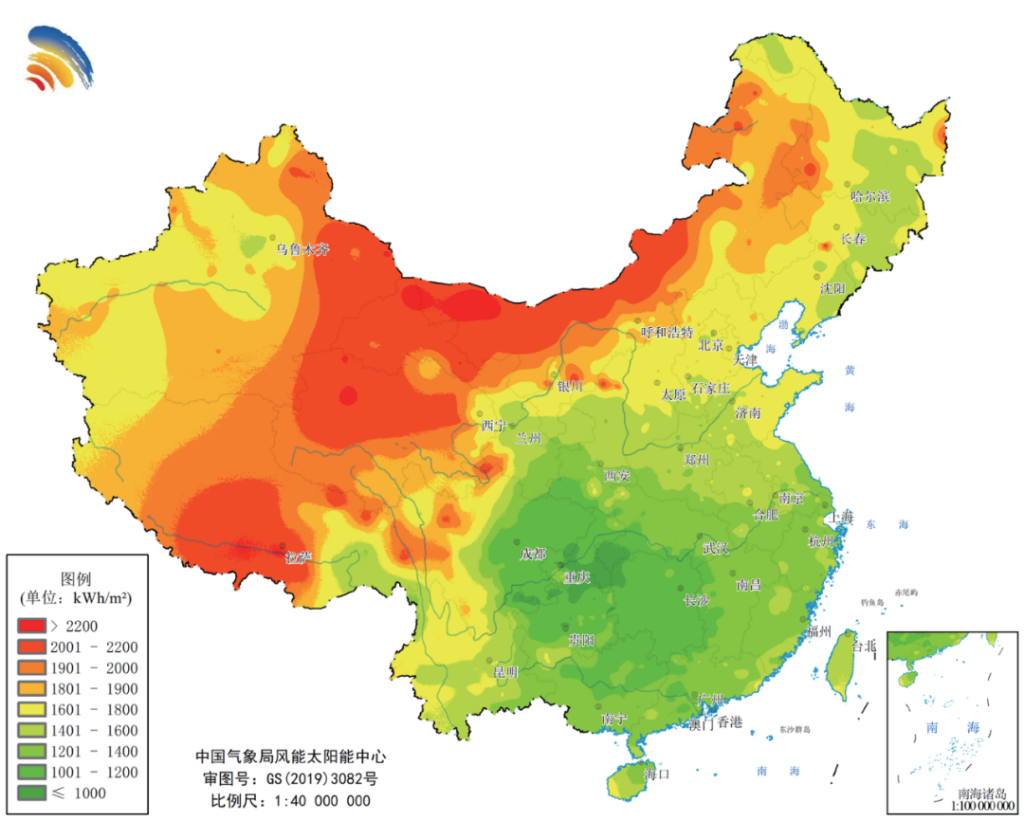
Distribution of total annual irradiation (in kWh/m²) on the optimal slopes for stationary photovoltaic power generation in the country in 2024
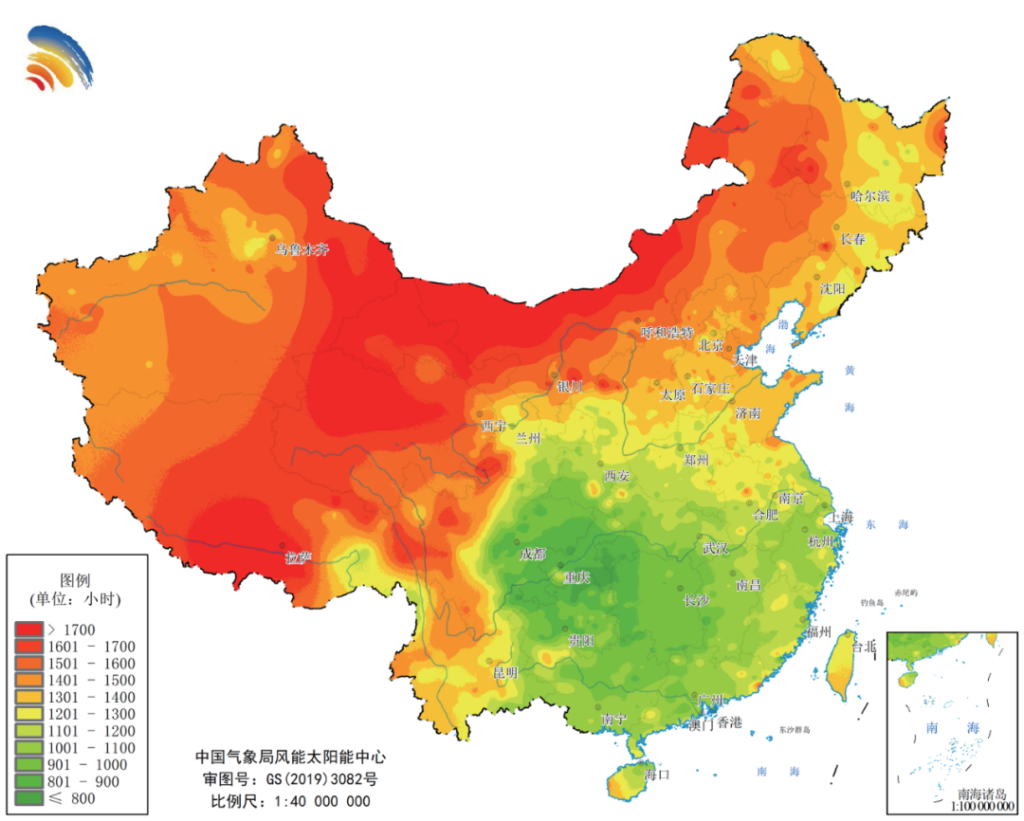
Distribution of first-year utilization hours of national stationary PV power generation in 2024 (in hours)
In 2024, except for eastern Sichuan, Chongqing, north-central Guizhou, Hunan, southwestern Hubei and northern Guangxi, the total irradiance of the best slopes in most areas of China will be more than 1200kWh/m2 , and the number of utilization hours in the first year will be more than 900, of which the total irradiance of the best slopes will be more than 1800kWh/m2 , and the number of utilization hours in the first year will be more than 1400. The total irradiance of the best slopes in the central-eastern part of Xinjiang, Qinghai, north-central Gansu, most of Inner Mongolia, most of Tibet, western Sichuan and other places is more than 1800kWh/m2 , and the number of utilization hours in the first year is more than 1400 hours; the number of utilization hours in the first year is generally less than 900 hours in the following places: eastern Sichuan, Chongqing, central-northern Guizhou, Hunan, southwestern Hubei, and northern Guangxi.

3. Optimal oblique total irradiance is smaller than normal in western and southern China and larger than normal in most of central and eastern China.
There are regional differences in the distribution of the total irradiation levels at the best slopes across the country, with western and southern China generally smaller than normal, and most of central and eastern China larger than normal (Fig. 2.8).
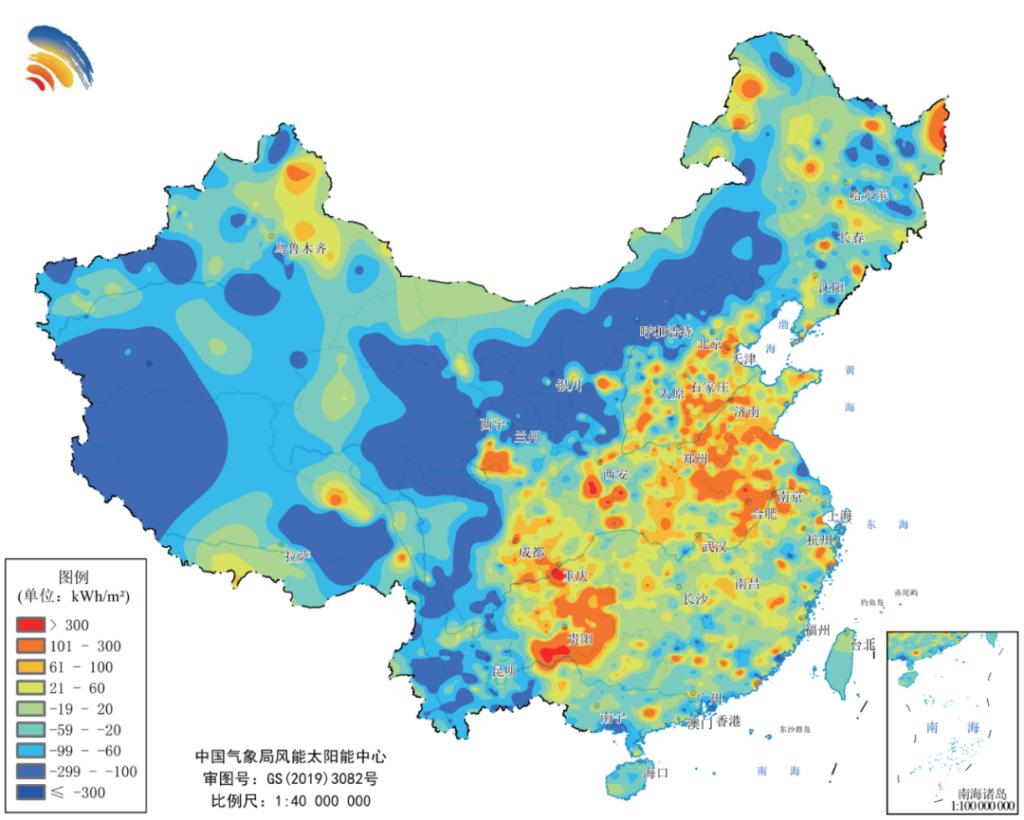
Distribution of annual optimal sloped total irradiation distance level (in kWh/m²) for stationary photovoltaic power generation in the country in 2024
In terms of the distribution of provinces (autonomous regions and municipalities) (Figure 2.9), the total annual irradiance of the best slopes in Ningxia, Tibet, Qinghai, Yunnan, Inner Mongolia, Gansu and Xinjiang is significantly smaller than the average value of the last 30 years; Hainan, Liaoning, Sichuan, Shaanxi, Beijing, Shanghai, Heilongjiang, and Hebei is smaller; Hubei and Jiangsu are larger; Henan, Shandong, Chongqing, Anhui, and Tianjin are significantly larger; and Guizhou is abnormally larger.
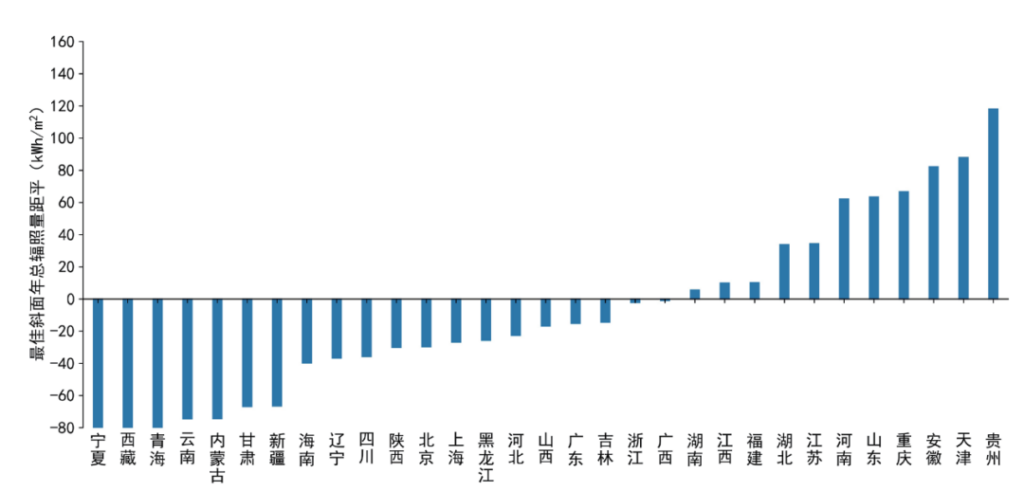
Distance level of total annual irradiation (unit: kWh/m²) of the optimal slope for stationary photovoltaic power generation in each province (autonomous region and city) in 2024
Special notice: Goodhao is reproduced from other websites for the purpose of transmitting more information rather than for profit, and at the same time does not mean to endorse its views or confirm its description, the content is for reference only. Copyright belongs to the original author, if there is infringement, please contact us to delete.


